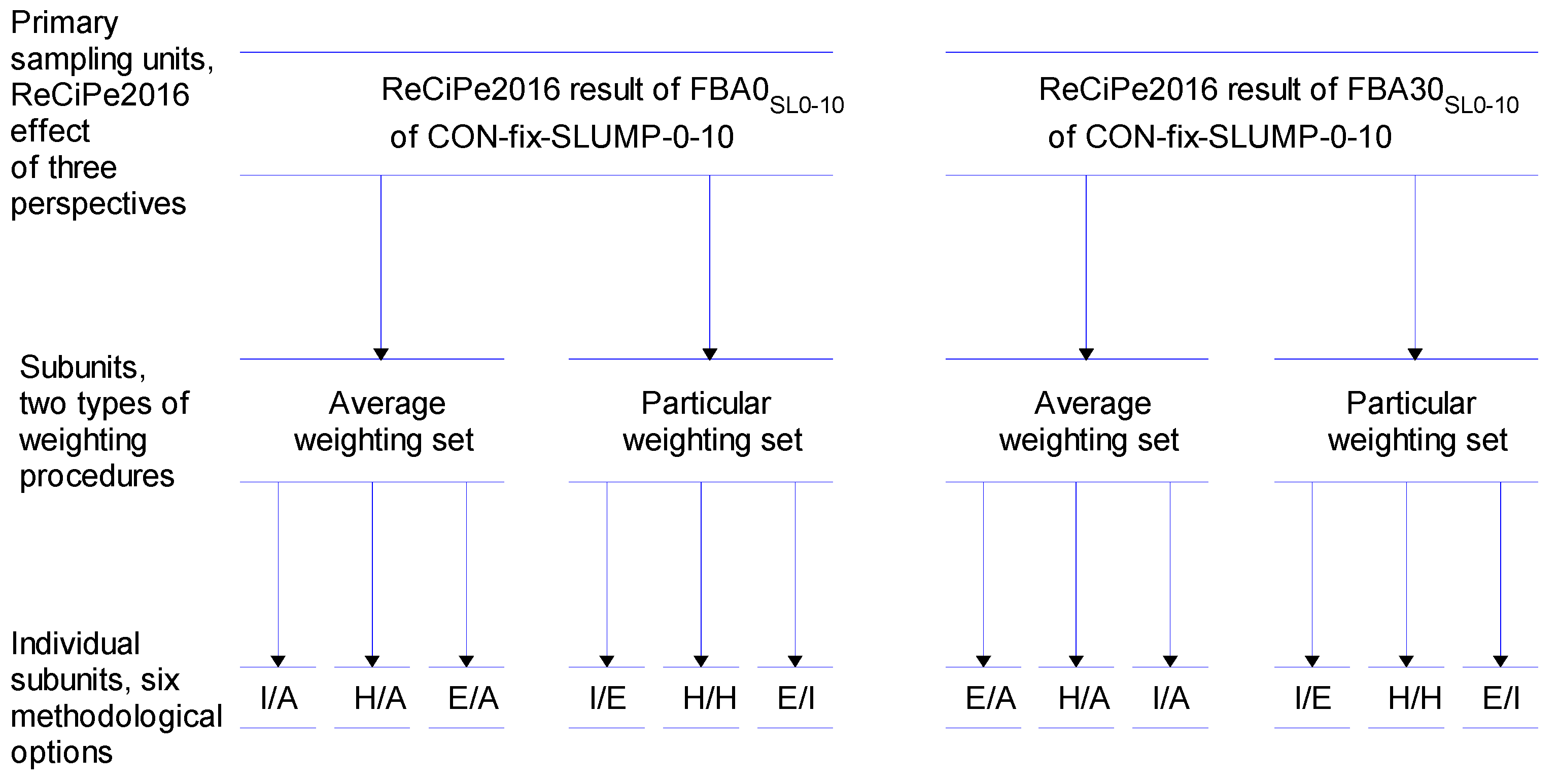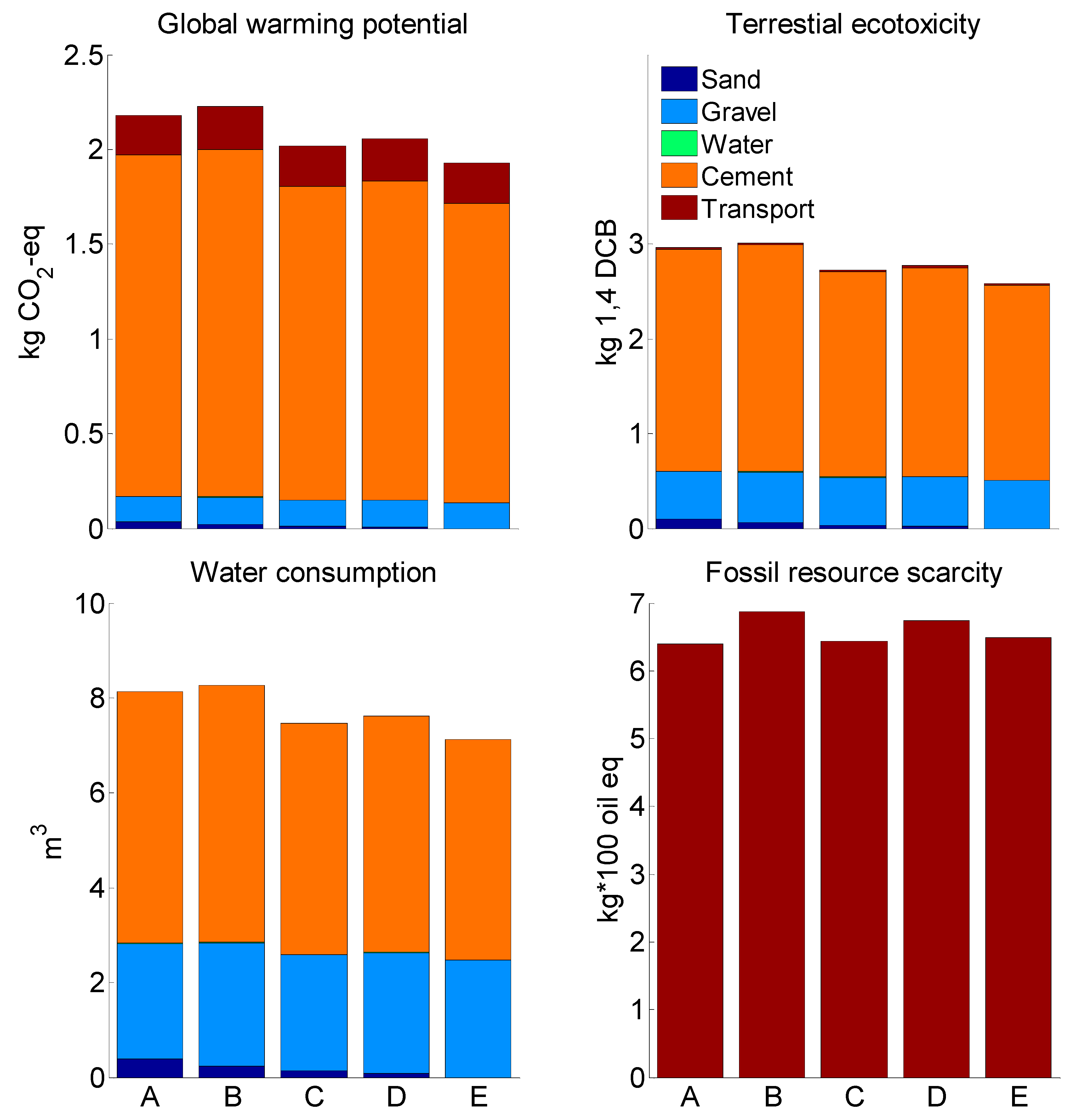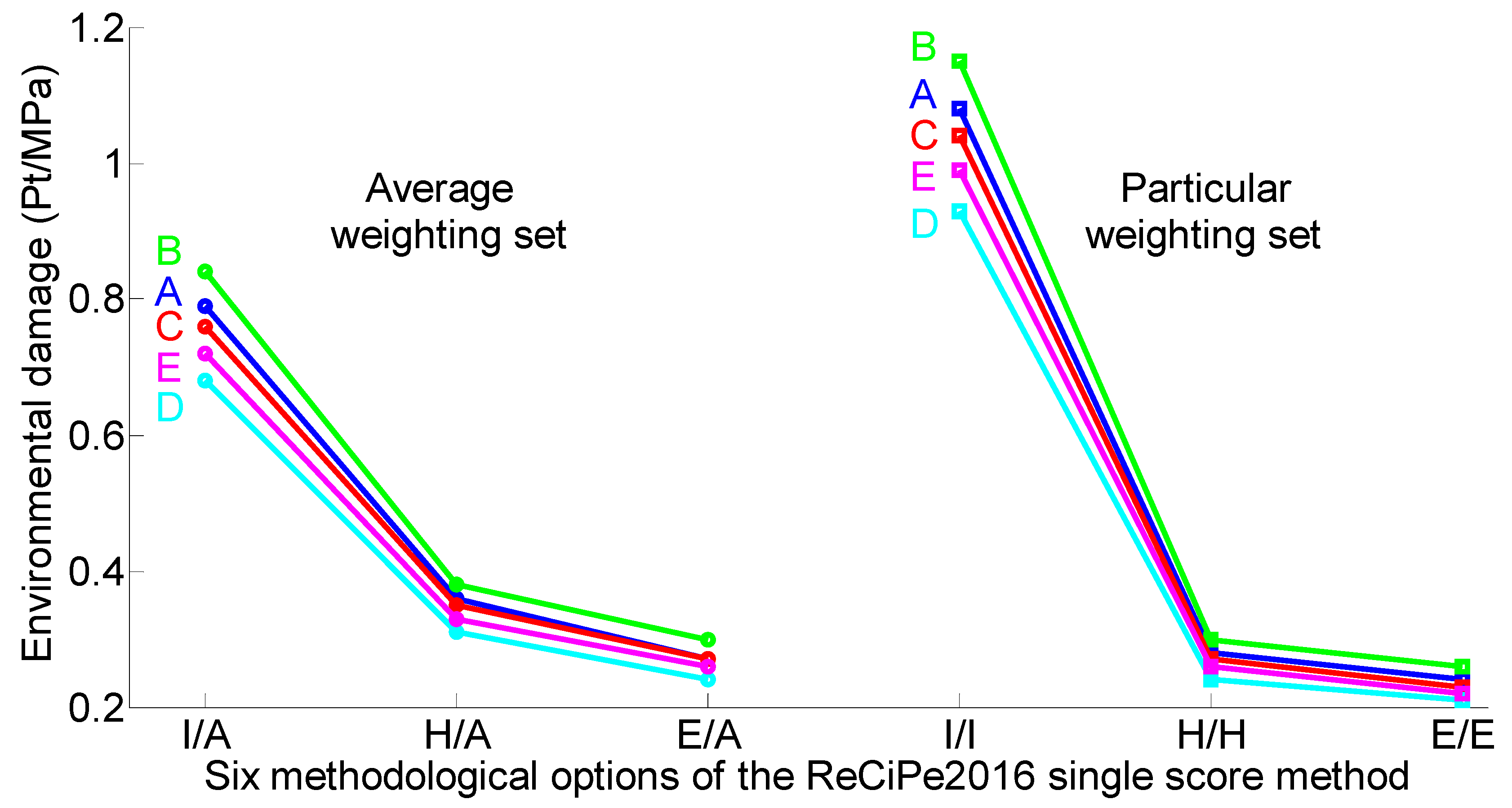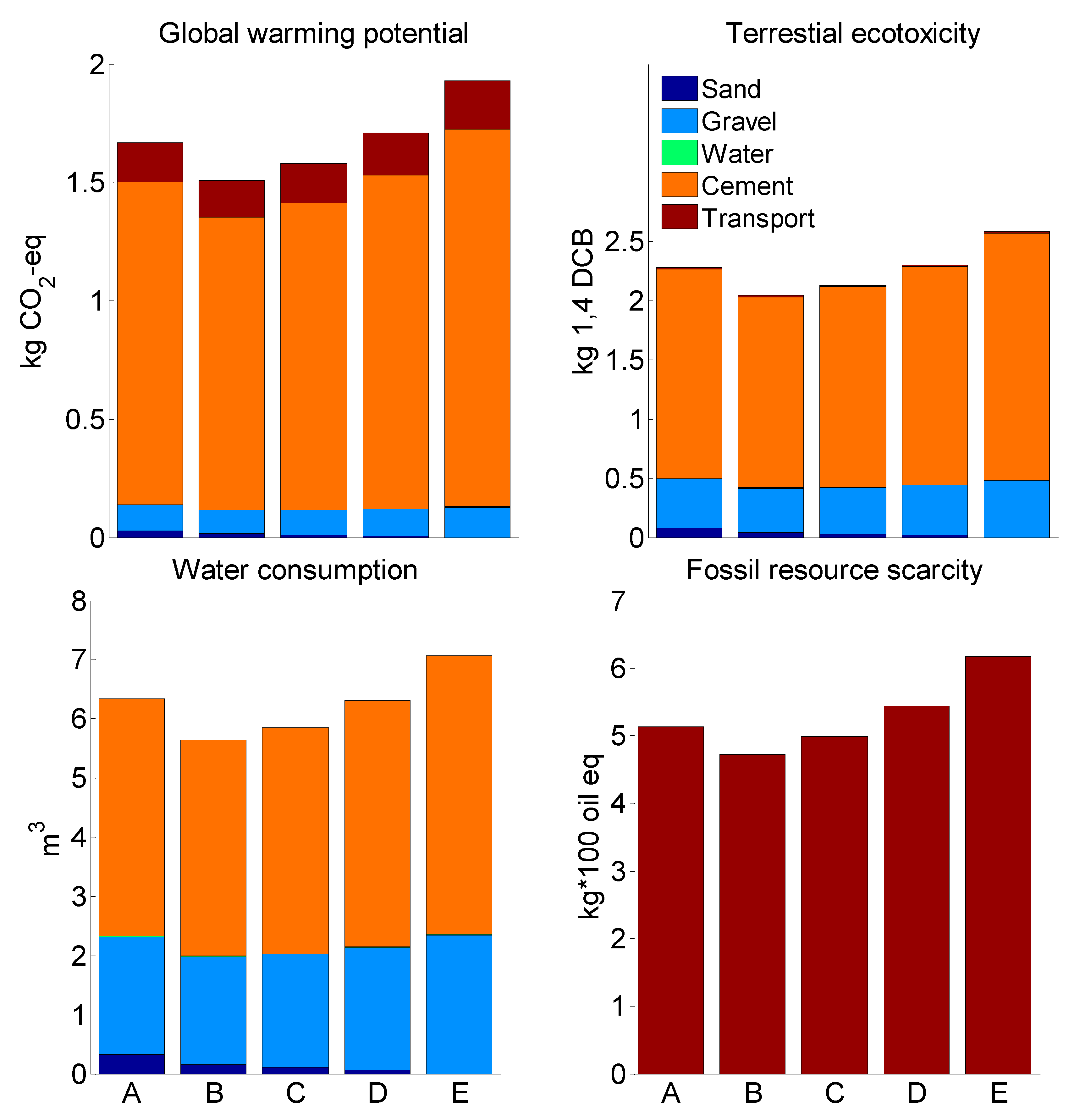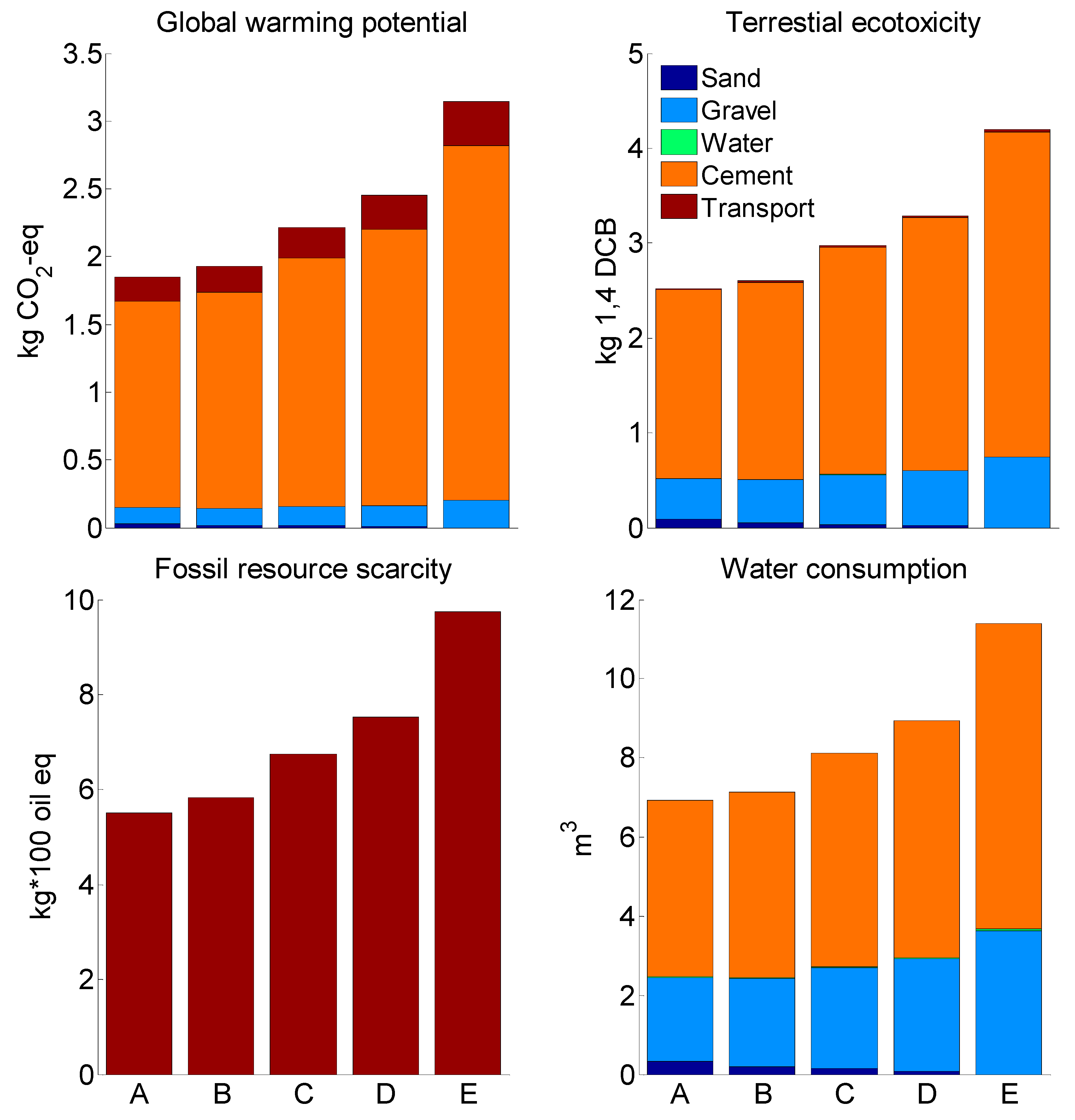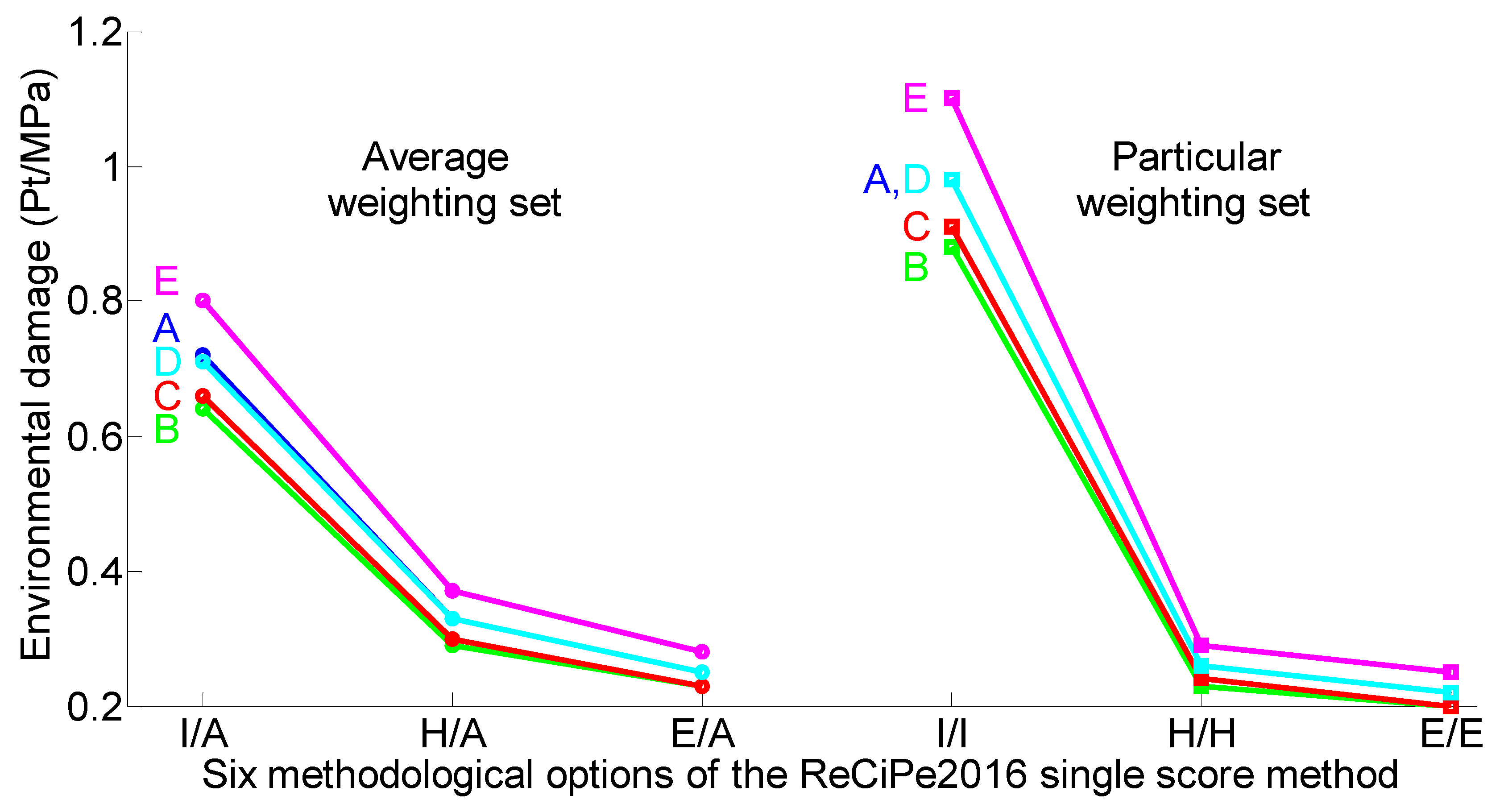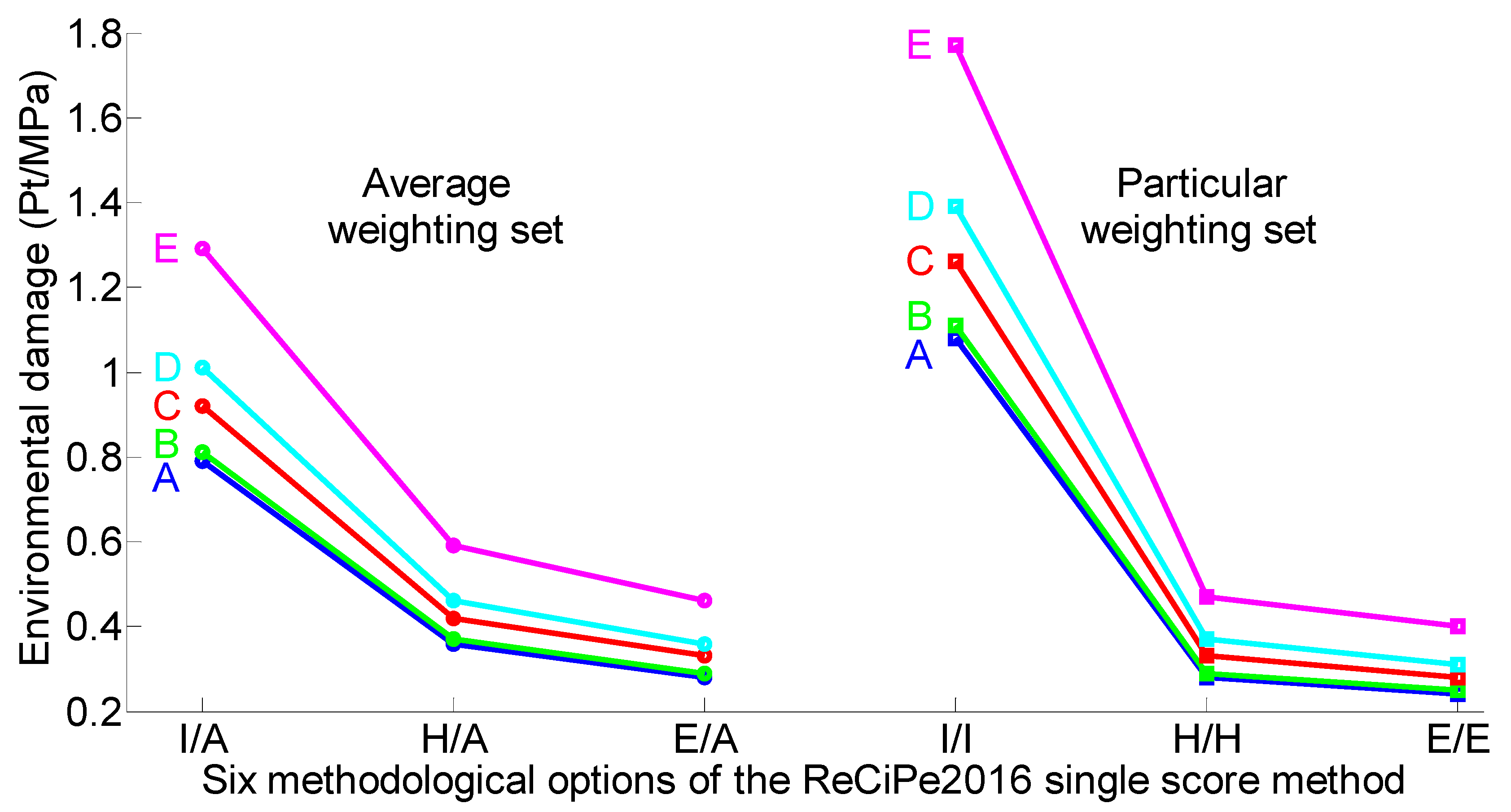1. Introduction
In the concrete industry, a common worldwide approach to reducing pollution is the replacement of cement with byproducts from other industries, such as fly ash (FA), furnace coal bottom-ash (FBA), and ground granulated blast furnace slag (GGBS) [
1,
2]. Such cement replacement has been widely studied in an effort to improve the mechanical performance, and reduce the cost and environmental impact, of byproduct-based concretes in comparison with conventional concretes. Many positive results have been reported in this area. For example, Phul et al. [
3] studied the mechanical performance of concrete with between 0% and 30% of cement replaced with GGBS and FA, and reported a 26.3% increase in the compressive strength. Additionally, Meng et al. [
4] studied the cost-effectiveness of ultra-high performance concretes (UHPC) with a high volume of cement replaced with Class C fly-ash (FAC), GGBS, and silica fume (SF), and with the complete replacement of quartz sand with conventional concrete sand. They reported that the cost of such mixtures was 4.1–4.5
$/m
3/MPa under standard concrete curing conditions. Furthermore, Saade et al. [
5] studied the environmental impacts of concretes with 66% of cement replaced with GBFS, and reported an approximate 40–70% decrease in the environmental impacts of the concrete, such as abiotic depletion, acidification, and eutrophication.
However, the depletion of natural aggregates such as gravel and sand is also a current environmental problem [
6]. Therefore, studies have investigated the replacement of sand with several industrial byproducts, such as FA, FBA, copper slag (CS), and quarry dust powder (QDP) [
7,
8,
9]. Chowdhury et al. [
7] studied the full replacement of sand with FA and FBA in road construction, and reported mixed results: climate change (e.g., CO
2 emissions) and environmental acidification were found to be lower for the byproducts, whereas the formation of particulate matter was found to be lower for the sand. Kua [
8] performed a life-cycle assessment (LCA) of high-performance concrete in which sand had been partially (10 vol%) replaced with CS, and reported an increased climate change impact (e.g., increased CO
2 emissions) compared to that of conventional concrete. Lim et al. [
9] studied the replacement of a high percentage of sand with QDP in lightweight foamed concrete, and reported a decrease in CO
2 emissions of up to 10%. This highlights that the effect of the partial or full substitution of sand in the production of concrete is not fully understood and requires additional research.
Among all the possible industrial byproducts, the conversion of waste from coal-fired electricity production into an environmentally friendly byproduct for the production of concrete is a pressing issue for environmentally sustainable development in many countries [
2]. For example, Zhang and Poon [
10] considered the use of FBA, a waste byproduct from coal-fired electricity production, as an alternative to natural fine aggregates in byproduct-based concrete production to improve the concrete’s environmental impact.
The problem of producing concrete with a low environmental impact is also important for Israel. Concrete is a major building material in Israel [
11], and furthermore, according to the Israel Electric Corporation Ltd., [
12] 50–57% of Israel’s electricity is produced from coal burning. In a recent study [
13], 18 wt% of sand was replaced with FA in concrete produced in Israel, and the authors reported significant improvements in the mechanical and chemical properties of the concrete. However, the environmental impact of concrete in which sand is partially or fully replaced with byproducts from Israeli coal-fired electricity production is unknown. LCA is an appropriate approach to elucidate the trade-offs of such replacements [
14]. A key element of LCA is a functional unit (FU) that must be shared by all the compared alternatives and to which all inputs and outputs of the raw materials, and their embodied energies and emissions, should be traced [
15].
For a proper comparison of the FUs of concrete alternatives (both conventional and byproduct-based), at least the following parameters should be comparable: (i) fresh properties of the concrete (e.g., the consistency); (ii) hardened properties of the concrete (e.g., the compressive strength); and (iii) the durability of the concrete (e.g., the water penetration). To achieve this, previous LCA studies have used two different concrete (CON) design methods: (i) concrete with a fixed slump range (CON-fix-SLUMP); or (ii) a concrete with a fixed water/cement (W/C) ratio (CON-fix-W/C) [
16,
17,
18].
Turk et al. [
16] used a fixed slump range of 185–205 mm in byproduct-based concretes in which sand had been partially replaced by foundry sand or steel slag and which contained FA as a mineral admixture. These authors showed that the ranges of the 28-day compressive strength and the water penetration depths were 30.1–45.3 MPa and 16–34 mm, respectively. Despite these conditions, the FU included the production of 1 m
3 of concrete without normalization to the 28-day compressive strength. Additionally, Turk et al. [
16] conducted consequential LCA modeling for the byproducts. This resulted in a reduced global warming potential (GWP), acidification potential, eutrophication potential, and photochemical ozone creation potential for the byproduct-based concretes compared to conventional concretes [
16].
Prem et al. [
17] compared conventional concretes (control) with byproduct-based concretes in which 100 vol% of sand had been replaced with CS for fixed W/C ratios of 0.37, 0.47, and 0.57. The absolute volume method was used when replacing sand with CS. This method limits the addition of any excess water, which can increase the W/C ratio and in turn reduce the strength of the concrete. As a result, the CS-based concretes demonstrated an improved strength (compressive and flexural) and durability (chloride permeability and chloride sorptivity) compared with conventional concretes. In the study of Prem et al. [
17], the FU of 1 m
3 of concrete was not normalized to the 28-day compressive strength. Additionally, byproduct-based concretes showed a higher embodied energy and GWP compared with conventional concretes. In this case, attributive LCA modeling was conducted, which entails that the environmental damage from CS production was attributed to the CS-based concretes [
17].
Gursel and Ostertag [
18] analyzed high-strength byproduct-based concretes in which sand had been replaced by CS at an incremental rate of 20 wt% (CS0:CS20:CS100) for a fixed W/C ratio of 0.3. The FU of 1 m
3 of concrete was normalized to the 28-day compressive strength, which was in the range of 65–98 MPa for CS0-SC100 concretes. Significant increases in the embodied energy, GWP, acidification potential, and particulate matter content were found for these concretes compared to conventional concretes. Therefore, to reduce the environmental impact of the concrete, Gursel and Ostertag [
18] suggested only replacing up to 40% of sand with CS.
Based on [
16,
17,
18], it should be assumed that the environmental impacts of byproduct-based concretes may depend on the selected concrete design method. However, the effect of different concrete designs on the LCAs of byproduct-based concretes with normalization to the 28-day compressive strength has not yet been considered.
Therefore, the aim of this study was to conduct LCAs of the FUs of concrete normalized to the 28-day compressive strength, with the natural material (sand) replaced by a byproduct (FBA) using two design methods: (i) concrete mixtures designed with fixed slump ranges of 0–10 mm and 30–60 mm (CON-fix-SLUMP); and (ii) concrete mixtures designed with fixed W/C ratios of 0.45 and 0.55 (CON-fix-W/C). For both design methods, the concrete mixtures and properties were based on those described by Bai et al. [
19] for the LCAs.
FBA was used as the sand-replacing material since this byproduct has a similar particle distribution to that of sand and a much lower pozzolanic activity than that of FA, which makes FBA less attractive for cement replacement, but appropriate for sand replacements [
6,
19].
The reason why both fixed-slump concrete and fixed W/C ratio concrete were studied is due to the fact that fixed-slump concrete has the same workability as fresh mixture alternatives, while fixed W/C ratio concrete has the same compressive strength as hard concrete alternatives. Moreover, it has been reported in the literature that using these different design methods for FBA-based concrete (in which sand was replaced with FBA) leads to different mechanical properties, such as compressive strength and drying shrinkage [
6,
19]. Therefore, this study investigated the influence of fixed-slump and fixed W/C FBA-based concrete design methods on the environmental impact of concrete.
4. Discussion
The purpose of this study was to conduct LCAs of byproduct-based concretes in which sand had been substituted with FBA in the following amounts: 0, 30, 50, 70, and 100 wt%. The LCAs of five concretes were evaluated, and the concretes were designed using the following two design methods: concretes with fixed slump ranges of 0–10 mm (CON-fix-SLUMP-0-10) and 30–60 mm (CON-fix-SLUMP-30-60); and concretes with fixed W/C ratios of 0.45 (CON-fix-W/C-0.45) and 0.55 (CON-fix-W/C-0.55). The environmental impacts of the concretes were determined using (i) the ReCiPe2016 midpoint H method and (ii) six methodological options of the ReCiPe2016 single-score method.
Based on the comparative LCA results of the FBA-based CON-fix-SLUMP and CON-fix-W/C concretes, it is difficult to determine which concrete has the lowest environmental impact. As sand was gradually replaced with FBA in the CON-fix-SLUMP concretes (CON-fix-SLUMP-0-10 and CON-fix-SLUMP-30-60), the environmental impacts of the concretes decreased (
Figure 2,
Figure 3,
Figure 4 and
Figure 5), whereas as sand was gradually replaced with FBA in the CON-fix-W/C concretes (CON-fix-W/C-0.45 and CON-fix-W/C-0.55), the environmental impacts of the concretes increased (
Figure 6,
Figure 7,
Figure 8 and
Figure 9).
The analysis of the CON-fix-W/C concretes confirmed the results of [
18], who designed byproduct-based concretes (CS was used as a byproduct) with fixed W/C ratios and recommended replacing sand with CS at up to 40 wt%. In the present study, we also recommended a similar percentage—up to 50 wt%—of sand replacement with FBA.
In contrast to the replacement of sand with byproducts, replacing cement with byproducts mainly yields environmental benefits. Crossin [
31] substituted 30% of cement with slag, and observed a decrease in greenhouse gas emissions of 47.5% compared with conventional concrete. Saade et al. [
5] substituted 66% of cement with slag, and observed a decrease in abiotic depletion, acidification, and eutrophication of 40–70%. Hossain et al. [
2] substituted 25% of cement with FA, and observed a reduction in the level of respiratory inorganics; global warming, e.g., CO
2 emissions; nonrenewable energy; and acidification of 20%, compared to conventional concrete.
Such inconsistencies in the environmental benefits of replacing sand or cement with byproducts can be associated with the different contributions from sand (0.3–2%) and cement (74–93%) to the total LCA of byproduct-based concretes [
32,
33]. The fact that sand makes such a small contribution to the total environmental impact of concrete means that the concrete design method (i.e., the fixed-slump or fixed W/C ratio methods) is a critical issue, with the choice of method affecting the results of the LCAs of the byproduct-based concretes.
In addition to the concrete design method, other factors contribute to the LCAs of the byproduct-based concretes, such as the byproduct modeling approaches (attributional or consequential) and the transportation distances (short or long). Turk et al. [
16] conducted consequential modeling of foundry sand or steel slag and confirmed their environmental benefits when used in concrete. Additionally, Prem et al. [
17] conducted attributional modeling of the use of CS in concrete, and confirmed that it had a negative environmental impact. With respect to transportation, Turk et al. [
16] studied the impact of different distances for the delivery of byproducts to the concrete batch plant, and found that environmental benefits were obtained for short distances (up to 100 km) and environmental damages were obtained for long distances (more than 100 km).
7. Limitations
Three main limitations of this study are recognized. The first is the number of byproducts that were used. To better understand the environmental consequences of replacing sand with byproducts from other industries, additional byproducts, such as slag, stone dust powder, and phosphate waste, should be analyzed in further research.
The second limitation is the lack of an optimization approach for the LCA of byproduct-based concretes. Meng et al. [
4] suggested an optimization mix design method for UHPC in which a high volume of cement was replaced with FAC, GGBS, and SF, and quartz sand was replaced with conventional concrete sand. According to this method, a wide range of concrete mixtures should be narrowed by the optimization of binder combinations, the W/C ratio, sand combination, the paste/sand volume ratio, and the steel fiber volume in order to ensure different fresh and hardened properties of the concretes, such as flowability, rheological properties, and compressive strength; then, the narrowed optimal set of design mixtures should be evaluated using the cost performance [
4]. This optimization method was also used by Meng and Khayat [
34], who added nanomaterials (graphite nanoplatelets and carbon nanofibers) to the mixture optimized by Meng et al. [
4] to improve the cracking resistance and the fracture toughness of the UHPC. Therefore, future research should consider using this optimization method to evaluate the environmental impacts of byproduct-based concretes.
The third limitation of this study is the lack of consideration of service life in the LCA of byproduct-based concretes. Recently, Coppola et al. [
35] suggested the use of an Empathetic Added Sustainability Index (EASI) to evaluate the environmental performance of byproduct-based concretes. According to this method, in addition to the production stage of the concretes, their service life (measured with performances such as bond to reinforcing steel, shrinkage, and shear properties) also needs to be considered when determining the concretes’ environmental impacts [
35]. Therefore, future researchers should consider using EASI to predict the LCA of byproduct-based concretes.
